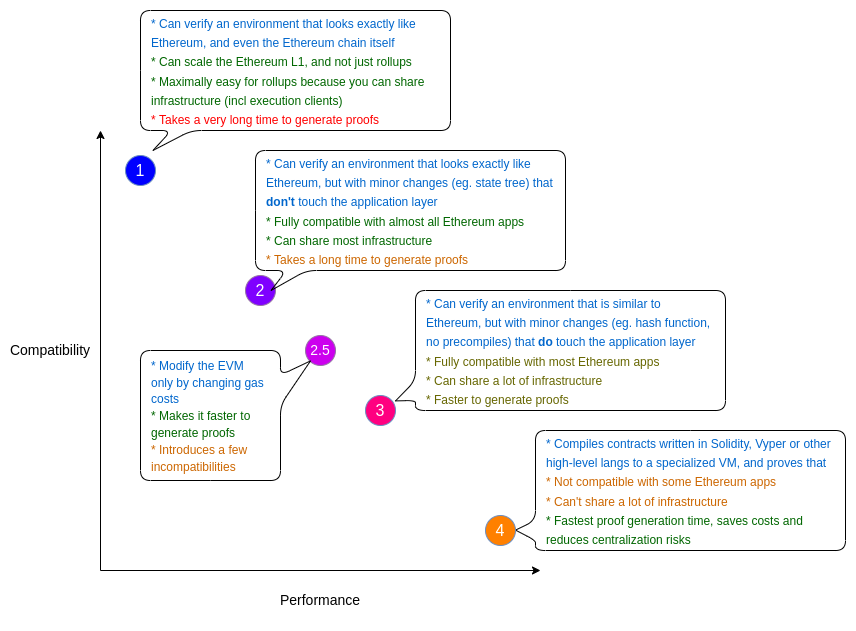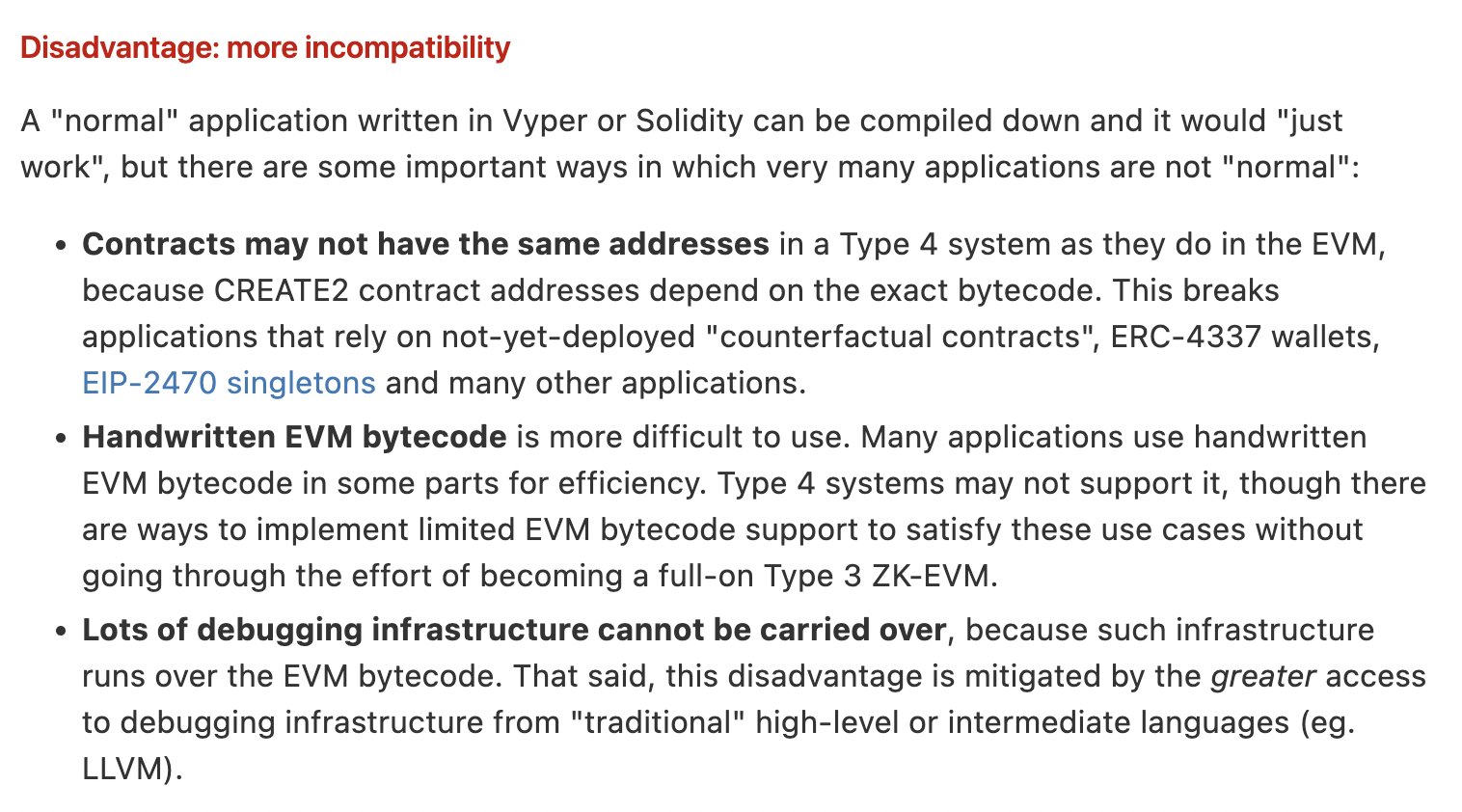
This Article is a summary of Vitalik's blog post, available here.
¶ ZK-EVM Taxonomy
¶ Prerequisites
¶ Zero-Knowledge Proofs
ZK-Proofs are a tool that mathematically prove the validity of a statement without sharing any information about it.
ZK-proofs allows one party (prover) to prove to another party (verifier) that a statement is true while also ensuring that the prover does not give the verifier any info that the verifier didn't already have.
All with cryptographic, mathematical certainty.
¶ The World Computer
Ethereum is the World Computer, a single, globally shared computing platform that exists in the space between a network of 1,000s of computers (nodes).
The nodes provide the hardware, the Ethereum Virtual Machine (EVM) provides the virtual computer and the blockchain records Ethereum's history.
¶ Ethereum Scaling
In order to scale without sacrificing decentralization, Ethereum is developing based on a rollup-centric roadmap.
Tl;dr transactions will be moved off-chain to high performance (likely centralized) rollups, while settlement will remain on Ethereum mainnet.
One of the more exciting applications of ZK-proofs are ZK-rollups, enabling layers on top of the World Computer that inherit the benefits Ethereum but are much more scalable.
This technology, with additional mainnet upgrades, will scale Ethereum to 100k+ txns/sec.
A ZK-rollup will bundle up all the transactions that occurred on the rollup chain and created a ZK-proof.
Although this proof is difficult to generate, it is very easy to verify.
Once generated, the new state, transactions and the ZK-proof are posted to a smart contract.
¶ ZK-EVM
ZK-rollups are not the only application of ZK-proofs, but the core functionality is shared across all ZK-proof projects: build cryptographic proofs of the execution of Ethereum(-like) transactions.
The first protocols were application specific (eg send payments).
But Ethereum is the World Computer; it is capable of so much more than sending payments.
Its computational capabilities are defined by the Ethereum Virtual Machine (EVM)…
…and the EVM is Turing-complete.
Projects that can process all possible EVM transactions are call ZK-EVMs.
Already there are multiple ZK-EVM projects gathering a lot of attention:
It's becoming more important than ever to understand the ZK-EVM landscape.
¶ The EVM Landscape

There are 4(ish) categories of ZK-EVM:
- Fully Ethereum-equivalent
- Fully EVM-equivalent
- 2.5) EVM-equivalent, except for gas costs
- Almost EVM-equivalent
- High-level-language equivalent
¶ Type 1: Fully Ethereum-Equivalent
Fully and uncompromisingly Ethereum equivalent, regardless of ZK-proof implications, both within the context of the EVM and within the context of Ethereum as a whole.
The goal of type 1 ZK-EVMs is to be able prove (execution-layer) blocks in full, as they exist on the blockchain.
Ultimately, type 1 ZK-EVMs are required to create trustless scaling of the World Computer.
But, at least today, they have drawbacks.
Ethereum was not originally designed around ZK-friendliness, so there are many parts of the Ethereum protocol that take a large amount of computation to ZK-prove.
At present, it takes at type 1 ZK-EVM many hours to produce and prove a block.
One of the particularly challenging data structures to create a ZK-proof for is a Merkle Tree, a data structure Ethereum used to store a lot of the system critical information, including the EVM state.
From within the EVM, applications don't see (most) Merkle Trees.
¶ Type 2: Fully EVM-Equivalent
Whereas type 1 ZK-EVMs aim to be equivalent within the entire context of Ethereum, type 2 ZK-EVMs aim to be equivalent only within the context of the EVM.
The goal of type 2 ZK-EVMs is to be fully compatible with existing World Computer applications, but they make modifications in block structure, state (Merkle) tree and other data structures.
All modifications are done in areas outside the awareness of applications, and so any application that works on Ethereum will work in a type-2 ZK-EVMs as well.
Most developer tooling will also work out of the box.
Unfortunately, while type-2 ZK-EVMs make major improvements over type-1s, they are still slow.
The ZK-unfriendly design choices were not just in how the network operates the EVM, its within the EVM itself. Type-2s run up against the same unoptimized EVM that Type-1s had.
¶ Type 2.5: EVM-Equivalent, Except for Gas Costs
Type 2.5 ZK-EVMs alter the gas costs of Ethereum transactions in order to disincentive the use of operations that are very difficult to ZK-prove.
Type 2.5s represent a significant optimization without major changes to the EVM. This can have implications on developer tooling and break some applications on the margin, but they are minimal and manageable.
Nevertheless, type 2.5s are a clear step away from the EVM.
¶ Type 3: Almost EVM-Equivalent
Type 2 ZK-EVMs make changes to the data structures outside the EVM, type 3 ZK-EVMs take it a step further and begin making changes within the ZK-EVM itself.
The main change is (usually) removing special functions called precompiles, but type 3s can also make changes to how code works.
While type 3 ZK-EVMs gain even further performance improvements, they begin to make big enough changes that they might break certain projects.
¶ Type 4: High-Level-Language Equivalent
Type 4 ZK-EVMs take regular EVM code and transforms (compiles) it to a different language that is much easier to ZK-prove.
There are huge benefits to this approach; the ZK tech can specialize and optimize, delivering incredible performance and a great platform for devs.
However, the point of a ZK-EVM is to process Ethereum transactions without a lot of work, and type 4s require a lot of work.
First and foremost, type 4 ZK-EVMs requires the development and maintenance of a whole new piece of software: the compiler.
Furthermore, type 4s begin to require real changes to smart contract code and break a lot of developer tooling.

¶ Conclusion
Types are not better or worse than each other; they simply have different trade-offs.
Furthermore, a ZK-EVM can move up or down in classification over time - it just depends what features they add and how Ethereum mainnet evolves over time.
¶ Resources
Source Material - Twitter Link
Source Material - PDF